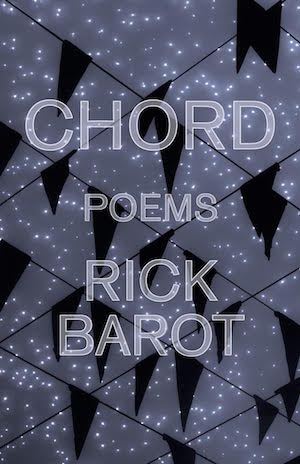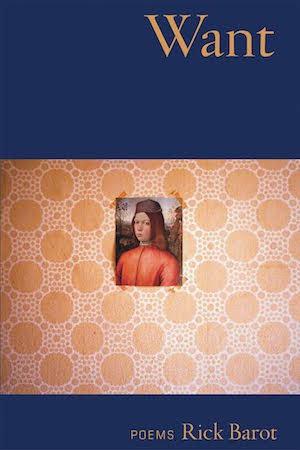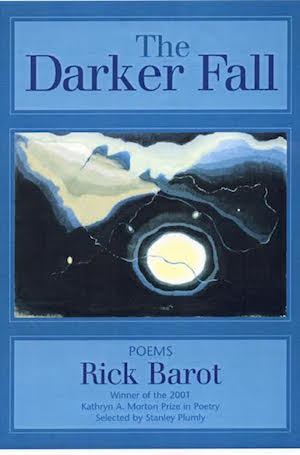
In the summer of 2009, when I learned that Sarabande Books was going to publish my collection of lyric essays, I had the good fortune of living close enough to the press to make a visit to their offices. Editor-in-chief Sarah Gorham led me into what would have been the original living room of the charming old house in the Louisville Highlands where Sarabande was headquartered then. She opened the largest cupboard I have ever seen—I’m certain it touched the ceiling—and invited me to choose any book I wanted (all Sarabande books, of course) from this delectable book pantry.
I scanned the shelves hungrily, but it didn’t take me long to decide which overdue library book on my shelf at home I wanted to return in favor of a permanent copy. That book was Rick Barot’s debut collection, The Darker Fall. I already knew I loved those poems—knew many of them in fact by heart—but I could not yet imagine that the poem “Blue Hours” from that collection contained the new title for my manuscript. In fact, Small Fires was the only title my editors and I found equally compelling and well-suited to my material.
For the last decade, I’ve been a dedicated reader of all Rick Barot’s books, from The Darker Fall (Sarabande, 2002) and Want (Sarabande, 2008) to Chord (Sarabande, 2015) and his forthcoming collection, The Galleons (Milkweed Editions, 2020). In 2015, Lambda Literary Review published my triptych review of Rick Barot’s evolving literary canon to date. Now in 2019, I finally have the pleasure of asking Rick Barot some of my many questions for The Rumpus.
***
The Rumpus: As I think you know, one of the first poems I teach in my introductory creative writing course is your “Child Holding Potato,” which I first encountered in Memorious 17 and later in Best American Poetry 2012. My students are fascinated by this poem—its crisp, spare, elegant lines, the sensuous, ekphrastic details—but also by the idea that this speaker would travel to an art museum (first? at all?) after receiving news that a family member was ill.
The poem may not be directly autobiographical, of course, but since you created someone on the page who “stared / at paintings that seem victorious // in their relation to time” and then went on to describe them vividly, I recognize as a reader that I am in the presence of a person who pays close attention to the visual field—not only to language but to image—and also to works of art where image is the only language.
Could you talk a bit about how the visual arts have influenced what you write, how you write, and how you think about writing? I wonder especially which paintings or sculptures or photographs in particular have shaped you as a literary artist and if you were ever drawn to creating images on canvas or film in addition to image-making on the page?
Rick Barot: I’ve never seriously tried my hand at another art form, but I always feel a happy envy when I encounter an artist or artwork that makes me stop and stare and think. The envy is with the tangible materiality that’s a part of the visual artist’s working life, which is a contrast to the out-of-thin-air that writing more or less comes from. The envy also has to do with the immediacy of the experience that a visual artist can generate in a viewer, which contrasts with a reader’s experience with a text and the slowing-down and patience that’s required there.
If anything, I’m probably a closet art historian. I try to look at as much art as I can—when I go anywhere new, I always orient myself by figuring out where the bookstores and museums are. Also, I read a lot of writing about art. Very little of the art that I see actually makes it into my poetry. When I think back to the poems I’ve written that were triggered by works of art, I can see that I was moved to respond when the artwork helped to crystallize some question or feeling or insight or idea that I’d been troubled by. The encounter with the artwork was certainly an occasion in itself, but more than that, the artwork helped me to work through something. I don’t mean to suggest that, in some totally self-serving way, we should only look at art as sources of insight about ourselves. Rather, I’m saying that we should pay attention to the things that arrest us and ask why this piece of art—and not another one—has arrested us.
You mention “Child Holding Potato,” and I’ll say that the “agenda” of that poem was to trouble the usual agenda found in ekphrastic poems. Art’s power to console, to provide spiritual and metaphysical deepening, to create pockets of contemplation, to provide aesthetic pleasure—these are the pay-offs that conventionally underwrite the ekphrastic endeavor. But as described in “Child Holding Potato,” I experienced something—my sister’s cancer diagnosis—that art couldn’t make right. As someone who puts a lot of stock in art, it was deeply instructive to come up against the limits of art to console. And worse, it was terrible to realize that art can serve as way of deflecting actual experience. “Child Holding Potato” is a kind of transcription of those lessons.
Rumpus: I’d like to ask you a bit more about poetic agendas—although I’m not sure if what I mean is specifically “agenda.” I may also mean credo or mission, purpose or intention, style or leitmotif—perhaps I mean all of the above. But the question is this: How would you, Rick Barot, describe a Rick Barot poem? What does such a poem typically do or seek to do? (Conversely, what does a Rick Barot poem typically not do—in terms of form, content, et al?) Put another way, poetry is a vast genre filled with many complex inhabitants that all answer to the name “poem.” How would you characterize your poems within that citizenry of Poetry Land (a phrase I borrow often and always with gratitude from my colleague, Campbell McGrath)?
Barot: As a teacher, I’m pretty comfortable talking about what poetry is, its place in the world, and the aesthetic, cultural, and social effects that poetry can have on readers. But that’s when I’m talking about poetry in general or about other people’s poetry. It’s much harder to think about, or talk about, my own poetry. You know that cringe-y feeling when you hear your own recorded voice? That’s usually how I feel when I think about my poems, or when I read my older work.
I don’t necessarily think of myself as a poet of autobiographical impulse, but I do know that capturing elements of my life—whether I’m writing about a hugely important life event or just describing a fleeting bit of perception or consciousness—is a vital reason for why I write poems. In that way, the poems are little containers for safekeeping, even if I’m the only one aware of the significance of certain gestures or images in the poems. Beyond that, I have real difficulty thinking about the purpose of my poetry in relation to the reader or the world that my poetry is a part of.
I hope my poems give readers a special experience of language and feeling. And I hope they add to people’s ideas about what love is, or identity, or history, or pain. Actually, in my last book, Chord, there’s a poem where I tried to figure out the question of what I think a poem is. The title and opening lines are: “The Poem Is a Letter Opener // and it is the letter that is answered / or not answered…” For now, at least, I like that formulation of what a poem—and by extension, poetry—is: it’s an intimate message for someone else, who may or may not care for that message. And it’s also the blade that reveals the message, with all the potential uses—for good or harm—that a blade has.
Rumpus: I read Chord as the culmination of a trilogy, but I’m curious if you experienced writing Chord that way?
Further questions: What has been your process of assemblage for your poetry collections to date? Do you think of certain poems as belonging to the same project while you are writing them? Is there always a larger project in mind as you’re poeming, or do you find the book only comes into focus for you after the majority of the poems have been written?
I’m curious to know how your own titles have arisen from the poems that comprise each collection, or if the titles themselves were guiding lights for the composition of those poems?
Barot: To start with your last question first: for me, the titles for individual poems come pretty early in the composition process, and they’re crucial to getting the process started in the first place. In the same way that the name of a constellation—Orion, say, or the Big Dipper—creates a story out of what would otherwise be a random array of stars, the title of a poem often gives me a way of organizing a bunch of elements floating in my consciousness. The title becomes a set of coordinates that the writing process travels towards.
As far as titles go, the difficulty I’ve had in the past is with book titles. While I was writing Chord, it had the working title of Looking at the Romans. Echo was the working title for Want. And the original title for The Darker Fall was Night & Hydrangea. For reasons not worth going into, I changed the titles once the books were accepted for publication. The only title change I regret is for The Darker Fall. If I’m lucky enough to have a volume of selected poems one day, I’m probably going to title it Night & Hydrangea, as a way of honoring that florid first title.
In terms of how each book came into being, it was different from book to book. The Darker Fall contained poems from my first ten years as a poet—apprentice years. The poems were written in response to things that happened in my life and in my intellect during my late teens and twenties. Want was written in about three years, and it was rigorously guided by one theme: desire. Someone reading that book wouldn’t necessarily see desire as the thematic through-line, but it was what informed my thinking as I wrote the poems. Desire not just as a feature of love and sex, but the desire that catalyzes seeing and storytelling. Because I felt so dictatorial to my creative self while I was writing Want, I swore that my next book wouldn’t be a “project” book. And so, the poems in Chord were written over a span of seven or so years without me considering overall themes or structures. I wanted the poems to just show up. After I’d written about sixty pages of work, I spread out the poems on my living room floor and tried to see what was there. It turned out that there were in fact thematic patterns among the poems, and those helped me to organize the poems into the book. Still, I tend to think of Chord as a rather loose gathering, much like my first book.
I certainly don’t think of my first three books as a trilogy, though I’m really intrigued by your idea. Of course, the books can’t help but feel like they belong together: after all, they’re ostensibly mapping out my ongoing life, the life that I’m living as I write poem after poem. Maybe Chord feels like the most “personal” of my books because it’s the most plainspoken. One thing I’m learning as a poet is that it takes a long time to arrive at a place where the voice of your linguistic self matches up with the voice of your everyday mouth and your everyday body.
Rumpus: I love to hear poets, especially those who are also teachers and mentors to other poets, as you are, talk about what they’re learning—what poetry continues to reveal to them over years of writing.
Which brings me to your newest book, The Galleons, forthcoming from Milkweed Editions next year, which I read as a departure in some ways from your earlier work. The metaphor of flight isn’t quite right for these poems, though words like “voyage” and “journey” certainly apply. I want to start by asking about the ten-poem sequence, from “The Galleons 1” to “The Galleons 10,” which spans the length of this book and sweeps the reader along in an unfolding narrative tide. Could you share a bit about how these poems evolved and ultimately guided this book to fruition? Like Want, do you see The Galleons as a “project book”? And since you mentioned research earlier when we were discussing the essay form, I want to mention how poignant I found the line that opens “The Galleons 2”: “Research is mourning, my friend says.” Was researching and writing this sequence of poems a mourning ritual for you?
Barot: Yes, I do consider The Galleons a project book. Part of what this means is that the poems were guided by a set of themes that I identified early on—themes that had to do with history and how we define history, colonialism and its evolution to present-day capitalism, and how a personal history, its brief arc of time, is situated in a longer and larger history. Because the themes were so clear and urgent to me at the start, the poems that illustrated them came to me quickly. It was as though everything I saw and did—whether it was looking at nannies pushing strollers in New York City or seeing Las Meninas, the Velázquez painting in the Prado—was related to those themes. In all of these surprising and exhilarating ways, the connections among disparate things kept presenting themselves in the poems. I wrote the book in about three years, and that quickness felt like a gift.
The ten-poem title sequence is about a lot of things, but at heart it’s an elegy for my grandmother, who died in 2016 at ninety-two years old. One of the iconic images that I have of her life is when she travelled by ship from the Philippines to the States in the late 1940s, with my grandfather and my toddler mother. It was a painful trip that took weeks across the Pacific. The image of her on that ship made me think of the long journey of her life, and how her migration story was haunted by the galleons’ journeys across the same ocean centuries before, carrying their imperial and commercial cargo from the Philippines back to Spain. One poem of the ten-poem sequence lists the nearly two hundred ships that naval historians have identified as the ships that were part of the Spanish galleon trade, which lasted for almost two hundred and fifty years. Immediately after that poem is a poem that depicts the moment of my grandmother’s death. That juxtaposition—of vast differences of scale, of complicated intimacies between the past and the present—is what the sequence and the book are really about.
As for the research that went into the book, I had the great luck of getting a fellowship from the Guggenheim Foundation during the early part of working on the book. It allowed me to take time away from teaching and travel to places where I could gaze directly on the places and artifacts of Spanish empire: the silver galleries in the Victoria and Albert Museum in London, the Royal Naval Museum in Madrid, churches and museums in the Philippines. What I did wasn’t research per se—not the systematic or question-driven research that someone writing a nonfiction or journalistic book might engage in. Instead, I looked and looked and paid attention to what my eyes lingered on, often not knowing why I was lingering on that object or that bit of information. Writing the poems became a way of figuring out the significance of what I had seen and learned.
One more thing: the friend who said that “Research is mourning” is the brilliant poet Brian Teare.
Rumpus: As The Galleons reckons with origins and histories, both personal and public, on a global scale, there are also a number of precise and striking references to the Pacific Northwest, where I am from originally and where you have settled now. For instance, imagine my delight when I encountered your poem “Cascades 501”—a train I used to take in college from Tacoma to visit friends in Portland and Eugene. I recognized a part of my own place-history in the lines, “Dense walls of trees. / Punky little woods. The living continually out-growing//the falling and decaying.”
By my estimate, you’ve been living in Tacoma, Washington, for more than a decade now, and I wonder how you find the landscape there—the Evergreen and ever-gray, the ubiquitous glimpses of Mount Rainier, et al.—but also how the social geographies and culture of the place—inform your writing.
What has your life in Tacoma/at Pacific Lutheran University and the Rainier Writing Workshop taught you about yourself as a writer, and what have you written that you could not imagine writing if you had ended up making your life in a different place?
Barot: This question about me being a Pacific Northwest poet—it’s a powerful question. To begin with, I’m never asked what it means for me to be a poet in the Pacific Northwest, and I wonder why that’s so. Perhaps my work doesn’t immediately signal place as a primary marker for who I am and where I am—though, as you point out, a careful reader will surely pick up on those markers or references, even if they’re subtle. I’m a writer in the Pacific Northwest working my way towards being a writer of the Pacific Northwest. Because I’ve lived here for almost fifteen years, the human and non-human contexts that surround me can’t help but make their way into my consciousness and into my poems—the same way that they would if I were living in, say, Indianapolis or New York City. In addition to being a poet in Tacoma, I also have other selves that are expressed here—as a teacher, a citizen, a member of various communities. And all of that manifests in my poems.
In the years that I’ve been in the Pacific Northwest, my understanding of the place—its long history, its natural beauty, and its dense culture—has broadened and deepened in a sort of concentric fashion. My teaching job at PLU is what brought me here, and so, initially, my awareness was informed by the strong commitment to social justice at the school. The ways I related to my students, the things I taught them—these were transformed by the ethical discourses that PLU is always trying to elevate. If I were teaching somewhere else, I know that I would be a very different teacher now. Beyond that first important awareness of what it meant to be here, there were other crucial understandings.
Being aware of the Native populations that were first here; the waves of white settlers, including the Norwegians who founded PLU and the lumber speculators who set in motion the systematic extraction of the region’s resources; the waves of ethnic immigrants, and the waves of tech people—these things complicated my sense of where I was. Being aware of the robust military presence in the Tacoma area, due to the two large military bases here—this was another complication. And being aware of the stunning mountains and waters all around, their fascinating geologic narratives, as well as learning of the current threats faced by our environment—this added to the love and care I felt for the place.
***
Photograph of Rick Barot by Rachel McCauley.







